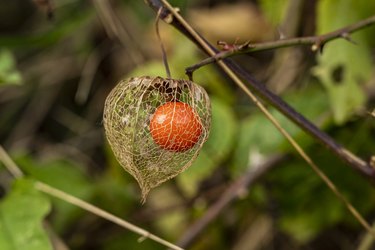

If you've ever visited an Asian supermarket or bakery, you might have noticed reddish-yellow berries surrounded by a papery husk hanging like lanterns off of a plant. These rare fruits are called Chinese lantern berries, also known as groundcherries, cape gooseberries and bladder cherries.
Chinese lantern berries belong to the nightshade family of fruits and vegetables, according to NC State University. Native to Asia and southern Europe, Chinese lantern berries are harder to come by in the U.S.
Video of the Day
Video of the Day
That said, if you are lucky enough to come across Chinese lantern berries, they have some great nutritional benefits and have a juicy sweet and sour flavor that'll complement many dishes.
Learn more about the nutritional value of Chinese lantern berries and how to prepare them at home.
Are Chinese Lantern Plants Edible?
Unripe Chinese lantern berries are poisonous, says Michelle Jaeline, RD, a registered dietitian who specializes in Asian food and cultural nutrition. When they're unripe, they have a green color, but as they turn ripe, they will develop a reddish-yellow hue.
"When they are ripe, they will fall off the plant to the ground surrounded by a papery husk. Ripe Chinese lantern berries are safe to eat," says Tia Glover, RD.
Chinese Lantern Berries Nutrition Facts
One cup of raw Chinese lantern berries has:
- Calories: 74
- Total fat: 1 g
- Cholesterol: 0 mg
- Sodium: 0 mg
- Total carbs: 15.7 g
- Dietary fiber: 0 g
- Sugar: 0 g
- Added sugar: 0 g
- Protein: 2.7 g
Chinese Lantern Berries Macronutrients
- Total fat: One cup of Chinese lantern berries contains 1 gram of total fat, including 0 grams of saturated fat and 0 grams of trans fats.
- Carbohydrates: One cup of Chinese lantern berries contains 15.7 grams of carbohydrates, including 0 grams of fiber and 0 grams of naturally occurring sugar.
- Protein: One cup of Chinese lantern berries contains 2.7 grams of protein.
Vitamins, Minerals and Other Micronutrients
- Vitamin A: 34% Daily Value (DV)
- Niacin (B3): 24% DV
- Vitamin C: 17% DV
- Thiamin (B1): 13% DV
- Iron: 8% DV
Health Benefits of Chinese Lantern Berries
1. They're High in Vitamin C
Similar to a cherry tomato, Chinese lantern berries boast high amounts of vitamin C, Jaelin says. Vitamin C is a water-soluble nutrient that aids in wound healing, bolsters your immune system and improves iron absorption, according to the National Institutes of Health (NIH).
The NIH recommends people assigned male at birth (AMAB) get at least 90 milligrams of vitamin C daily and people assigned female at birth (AFAB) get 75 milligrams. Meanwhile, pregnant people need 85 milligrams daily and those who are breastfeeding require 120 milligrams.
2. Chinese Lantern Berries Are Rich in Potassium
"Chinese lantern berries are also high in potassium, which can help prevent high blood pressure and kidney stones, as well as maintain strong bones," Glover says.
Fruits and vegetables in the nightshade family, such as Chinese lantern berries, have notable amounts of potassium and also have withanolides, a type of steroid that has anti-inflammatory properties, according to a May 2020 review article in Plant Foods for Human Nutrition.
3. They Supply Vitamin A
Thanks to their bright reddish-yellow hue, Chinese lantern berries contribute to your daily needs for vitamin A, Jaelin says. This fat-soluble nutrient is essential for healthy eyes, heart and lungs, per the NIH.
According to the NIH, people AMAB need 900 micrograms of retinol activity equivalents (RAE), a measure of vitamin A content in food, and people AFAB need 700 micrograms.
How to Eat Chinese Lantern Berries
1. Raw
You can enjoy Chinese lantern berries much like any other berry, Glover says. Make sure to pick the berries only when the husk turns a beige or cream color. If you pick it while the flower is still bright red, the berry will be too sour to eat or use.
Pull down the husk to reveal the yellowish berry. You can eat it right off the stem as a snack, similar to grapes.
2. In Recipes
Because they have a tart flavor, they lend to a variety of dishes. Many people use them in recipes where they'd otherwise use cherry tomatoes.
Jaelin suggests adding Chinese lantern berries to salads, yogurt, salsas, jams and pies.
3. As a Pie Filling
You can use the unripened lantern berries for a pie filling by filling a pie crust with 4 cups of Chinese lantern berries and sugar to taste.
Although too sour to eat raw, cooking Chinese lantern berries with sugar softens them and gives them more of a tart taste.
4. As a Sauce
Substitute Chinese lantern berries for cranberries in a savory sauce that pairs beautifully with turkey, pork, fish or other meat.
Just add 1 tablespoon of sugar for every ½ cup of berries and a small splash of water in a saucepan and cook over low heat for about 15 minutes. Once the berries are soft, you can puree the mixture with any other ingredients you like.
You may want to add the sugar after the berries finish cooking to avoid making the sauce too sweet.